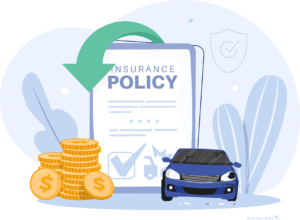
A Guide to Collision Auto Insurance Coverage
Just because collision coverage isn’t legally required doesn’t mean you should skip it.
Get quotes from providers in your area

No one wants to pay more for auto insurance than necessary, but if you skip out on collision coverage, you might have to pay thousands of dollars down the road. The truth is that the baseline state-mandated legal requirements for auto insurance coverage only cover damage to another person, not your own damages to repair or replace your vehicle. That’s where collision coverage comes in.
Collision Auto Insurance Coverage
What is collision insurance, and will it pay to repair your car after an at-fault accident?
Definition
Collision insurance is a type of auto insurance coverage that reimburses you for damages to your vehicle due to an at-fault accident.
How Does It Work?
In other words, if you run into another vehicle or object, collision insurance will cover your car’s damages up to its fair market value, after you’ve met your deductible.
What Does It Cover?
Collision insurance covers the following:
- Your car’s damages from accidents where you’re at fault
- Damage from potholes
- Damage from rolling cars
What Doesn’t It Cover?
Collision insurance doesn’t cover the following:
- The other person’s property damages or bodily injuries (liability insurance)
- Damages or injuries from accidents where you were not at fault
- Mechanical wear and tear
- Damages from weather-related events like hail, fires, and floods
- Car theft
- Car vandalism
- Your bodily injuries from an at-fault accident
Collision Deductibles
Unlike liability coverage, collision coverage comes with a deductible. How do deductibles work? If you get into an at-fault accident and your auto insurance company covers your claim, you’ll have to pay the deductible amount before the company will pay for the rest of the damages.
You’ll typically pick out your collision deductible with your agent when choosing a policy. The average deductible amount for collision coverage is $500. The higher the deductible, the lower your premiums will be. Learn more in our deductible FAQs.
Collision Limits
Your collision limit, or the highest amount your insurance provider will reimburse for damage, will be equal to the fair market value of your car. This means that, aside from your deductible, collision coverage will pay for all damages to your car unless they cost more than the car’s fair market value. If the cost to fix any damages exceeds the fair market value of the car, your car is declared a “total loss” or “totaled.” In this case, your insurance company will pay you the car’s fair market value, which you can use to purchase or lease another vehicle.
Do You Need Collision Coverage?
Not everyone needs collision coverage, but if you have a new car, we recommend it.
Is It Required?
No state requires collision coverage as minimum coverage. That means you won’t get in legal trouble for driving without it.

Note
While collision coverage isn’t required, it’s part of full coverage, which includes liability coverage, uninsured motorist coverage, and comprehensive coverage.
Who Needs Collision Coverage?
Wondering how much car insurance you need? You need collision coverage if:
- You drive a relatively new car.
- You could get into a car accident that requires you to replace or repair your car, whether a single-car accident or a multi-car accident involving another vehicle.
Who Doesn’t Need Collision Coverage?
You don’t need collision coverage if:
- You have an older car, and the additional collision premiums amount to more than what the car is worth.
- You don’t drive your car because it’s broken down or in storage.
When it comes to insurance for cars that don’t run, you can go with comprehensive only,1 which we’ll explain further below.
The Cost of Collision Coverage
Collision coverage isn’t available on its own. Rather, it’s an add-on to liability insurance. The average insurance cost for collision coverage is around $260 to $550, based on the most recent NAIC data from 2021. Learn more about the cost of auto insurance in this chart.

| State | Average annual expenditure for collision coverage in 2021 by state (lowest to highest) |
|---|---|
| Wisconsin | $248.14 |
| South Dakota | $256.10 |
| Iowa | $257.26 |
| Oregon | $269.64 |
| North Dakota | $274.84 |
| Idaho | $275.30 |
| Minnesota | $278.02 |
| Kansas | $279.75 |
| Nebraska | $282.97 |
| Indiana | $284.64 |
| Wyoming | $287.22 |
| Kentucky | $288.99 |
| Ohio | $293.66 |
| Maine | $294.19 |
| Montana | $294.40 |
| Utah | $307.21 |
| New Mexico | $308.71 |
| Missouri | $317.59 |
| Washington | $318.06 |
| South Carolina | $319.00 |
| Arizona | $322.58 |
| Virginia | $323.32 |
| New Hampshire | $325.72 |
| Colorado | $327.90 |
| Vermont | $330.50 |
| Oklahoma | $335.27 |
| Florida | $339.81 |
| West Virginia | $346.14 |
| North Carolina | $346.87 |
| Tennessee | $350.92 |
| Delaware | $351.95 |
| Illinois | $354.72 |
| Nevada | $356.59 |
| Mississippi | $368.73 |
| Hawaii | $371.46 |
| Pennsylvania | $371.61 |
| Arkansas | $373.69 |
| Alabama | $378.16 |
| Alaska | $404.30 |
| Connecticut | $409.17 |
| Georgia | $416.28 |
| Maryland | $418.88 |
| New Jersey | $422.61 |
| Texas | $424.72 |
| Massachusetts | $439.94 |
| Louisiana | $452.79 |
| Michigan | $456.27 |
| New York | $476.20 |
| Rhode Island | $502.95 |
| California | $509.84 |
| Washington, D.C.2 | $544.08 |
FYI
The average incurred loss for each collision claim in 2020 was $5,215.3
Collision vs. Comprehensive Coverage
Want to know more about the differences between collision and comprehensive coverage? See the chart below to learn more about comprehensive coverage.
| Type of coverage | Collision coverage | Comprehensive coverage |
|---|---|---|
| Covers your property damages in an at-fault collision | Yes | No |
| Covers damages from potholes | Yes | No |
| Covers damages from a rolling car | Yes | No |
| Covers damages from weather-related incidents like hail, floods, and fires | No | Yes |
| Covers auto theft | No | Yes |
| Covers auto vandalism | No | Yes |
| Necessary for old cars | No | No |
| Necessary for new cars | Yes | Yes |
| Necessary for broken-down cars | No | Yes |
| Necessary for cars in storage | No | Yes |
In sum, comprehensive coverage pays for damages to your car from all events other than collisions, including flood coverage, hail coverage, natural disasters coverage, and sinkholes coverage. If someone steals your car, steals parts of your car, or vandalizes your car, that’ll also fall under comprehensive coverage.
In contrast, collision coverage covers damage from potholes and road hazards, along with at-fault accidents. If a car accident is your fault, collision coverage is what you’ll depend on to get your car repaired or replaced.
Recap
To learn more about collision coverage, read our frequently asked questions below. While the law doesn’t require collision coverage anywhere in the U.S., we recommend it except for an old car or a car you’re not driving. Car repairs can cost thousands of dollars, so if an accident is your fault, you won’t want to pay out of pocket for repairs or replacements. If you have collision insurance, your insurer will pay you up to your car’s fair market value. If you’re considering collision coverage, check out our recommendations for the best insurance companies for full coverage.
Frequently Asked Questions
If you’re still a bit confused about collision coverage, keep reading our FAQs.
Collision coverage protects you against paying for your car repair or replacement after you get into an at-fault accident with another vehicle or property. It also covers damage from potholes and rolling cars.
If you have a relatively new car that you are actively driving, then collision coverage is worth it. It costs an average of about $377 per year, as of the most recent 2021 data from the National Association of Insurance Commissioners. However, if you get into an at-fault accident, it will cover your car up to its fair market value, which is much more than $377 in most cases.
Collision coverage is not the same as full coverage. Collision coverage falls under full coverage but doesn’t cover the following:
- The other party’s property damages and bodily injuries in an at-fault accident
- Uninsured or underinsured motorists
- Auto theft
- Vandalism
- Damages from weather-related events
Comprehensive and collision coverage cover the following:
- Your car’s repair or replacement costs in an at-fault accident
- Damages from potholes
- Damages from rolling cars
- Auto theft
- Vandalism
- Damages from weather-related events
Citations
Do you need insurance for a car in storage? Progressive. (2022).
https://www.progressive.com/answers/insurance-car-in-storage/2020/2021 Auto Insurance Database Report. NAIC. (2024, Jan).
https://content.naic.org/sites/default/files/publication-aut-pb-auto-insurance-database.pdfNews Release. NAIC. (2024, Mar 11).
https://content.naic.org/article/naic-releases-2020-2021-auto-insurance-database-report

